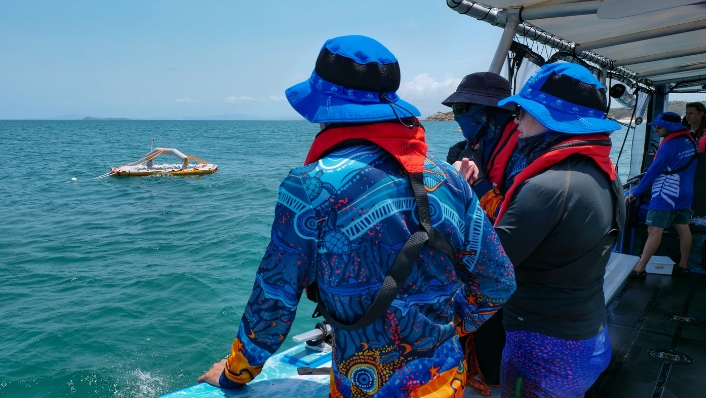First Nation's Rangers are partnering with scientists from the Australian Institute of Marine Science (AIMS) to take restoration research out of the laboratory and onto the Great Barrier Reef (GBR) throughout November.
About 20 Rangers from six Traditional Owner groups are gathering on Woppaburra sea Country in the Keppel Islands, just off the coast of Yeppoon to upskill and build their knowledge of innovative techniques that harness the Reef's way of reproducing, replenishing and adapting during coral spawning.
These techniques were developed through the Reef Restoration and Adaptation Program (RRAP) and will form part of the largest reef restoration field testing activities to date, all centred around the annual mass coral spawning event on the Great Barrier Reef which began last week.

Working from boats on Woppaburra Sea Country and in classrooms at Rosslyn Bay, these Rangers have been gathering coral spawn and nurturing coral larvae and will deploy millions of these young corals back onto the area's reefs, many of which were hit hard by the 2024 mass bleaching event - one of the most serious and extensive to affect the GBR.
Known as Indigenous Futures , the project's lead Jordan Ivey, from AIMS, said the activities would empower participants to lead reef restoration activities for their sea Countries. This trial project is part of the RRAP Pilot Deployments Program (PDP) that is activating Traditional Owners, industry and communities to become reef restoration practitioners.
"Helping a system as large as the Great Barrier Reef needs 'all hands on deck', and we are proud to work with Traditional Owners to empower them via the training and experiences we are sharing," said Mr Ivey.
"This project provides a pathway to qualifications for Indigenous Rangers and will immerse them in efforts to help coral reefs recover more quickly from the impacts of climate change.
"We need people power now and into the future, to help repair damaged reefs and fast-track their recovery. Indigenous Rangers, with their deep spiritual and cultural connections to sea Country, are the ideal partners to help us achieve these goals.
"These efforts will also help AIMS scientists and partners build on foundational knowledge of how best to make interventions work across large scales."

Tshinta Barney from the Woppaburra Land and Sea Rangers said the work was important because it was looking after Sea Country.
"It is a part of our DNA, it's a part of our culture. We take care of Country. Country takes care of us. That's why we all have such a great passion for land and sea and what we do, no matter what project or event it is," she said.
She added that the partnership between the Indigenous Rangers and the scientists and technicians from AIMS was an exchange of knowledge, learning and communication.
"We interact and have very good yarns about culture and research and data, and try to work it all into this one project.
"I think the beautiful part of it all is that we're all willing to take the next step in closing the gap, so they say. And that's really important in this day and age and for future generations."

AIMS scientists have also collected 60 coral colonies from Keppel Islands reefs that will spawn in AIMS' state of the art aquaculture facility - the National Sea Simulator, in Townsville. Following spawning, these young corals will be transported back to Woppaburra sea Country for deployment by AIMS scientists in December.
The efforts in Woppaburra sea Country are a continuation of the Indigenous Futures project. Previously the project has worked on spawning events in the Whitsundays and Heron Island .
In Woppaburra Sea country, the Indigenous Rangers will be learning:
- The collection of coral sperm and eggs following spawning and rearing these to make coral larvae.
- The rearing of coral larvae in five coral larval pools and when ready, deploying millions of free-floating larvae to selected reefs via these pools.
- Settling larvae onto 15,000 devices in 10 pools and deploying these devices onto selected reefs.
- Marine monitoring using technologies developed at AIMS including ReefScan , ReefCloud , photogrammetry and methodologies used in the NAMMA program.
- Theory based training in coral larval restoration and monitoring.

The three-year Indigenous Futures project began in 2023 and includes formal accreditation units for participants within the Certificate III in Conservation and Ecosystem Management. By aligning the project with the PDP, these First Nations Rangers will continue to develop their reef restoration training and development in a real-world context until 2028.
The Indigenous Futures project is supported by AIMS, the Australian Government Reef Trust Partnership with the Great Barrier Reef Foundation, and RRAP.
Participants from the following Ranger groups are involved: Woppaburra, Gidarjil, Darumbal, Yuku Baja Muliku, Minggamingga and Gudjuda. Their home sea Countries range from south of Cooktown to south of Bundaberg.
AIMS scientists are also working with the marine and tourism industry in the Cairns/Port Douglas region to deliver millions more young corals to reefs in December and January as part of the three-year PDP trial.
The PDP is funded by the Australian Government's Reef Trust and led by the Australian Institute of Marine Science. It is part of RRAP, funded by the partnership between the Reef Trust and the Great Barrier Reef Foundation.
The use of the coral larval rearing pools is through AIMS' collaborations with:
- Professor Peter Harrison from Southern Cross University; and
- SECORE International, whose pools are referred to as CRIBs (Coral Rearing In-situ Basins).






